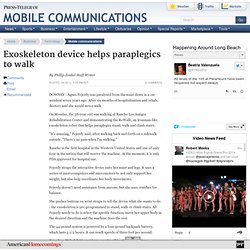

* Scary dog robot. Boston Dynamics shows a quieter, more thoroughbred AlphaDog to DARPA and the Marines (video) Cheetah, Boston Dynamics: Dedicated to the Science and Art of How Things Move. Boston Dynamics: Dedicated to the Science and Art of How Things Move. U.S. Robotics Start-Up Hstar Technologies’ Military, Nurse Bots. It looks like Vecna Robotics’ battlefield soldier extraction robot Bear will have some competition thanks to a U.S. robotics start-up developing similar robots.

Formed by MIT alumni sometime around 2007, Hstar Technologies is partnering with a number of tech companies and medical institutions, including the Harvard Medical School and Veterans Hospital. Among their first products to enter the market will be the RehaBot, which exercises the upper and lower limbs of patients severely impaired by musculoskeletal and traumatic brain injuries. Another major project in the works is RoNA (Robotic Nursing Assistant), which can lift and move patients in excess of 136 kg (300 lbs).
As already pointed out by Japanese researchers working on a similar nursing assistant called RIBA, nurses risk serious injury when lifting patients. According to Hstar Technologies, nurses sustain more injuries than any other U.S. profession and most occur when moving patients. Media: Image credit: Hstar Technologies. Powered exoskeleton. The exhibit "future soldier", designed by the US Army A powered exoskeleton, also known as powered armor, exoframe, or exosuit, is a mobile machine consisting primarily of an outer framework (akin to an insect's exoskeleton) worn by a person, and a powered system of motors or hydraulics that delivers at least part of the energy for limb movement.

The main function of a powered exoskeleton is to assist the wearer by boosting their strength and endurance. They are commonly designed for military use, to help soldiers carry heavy loads both in and out of combat. In civilian areas, similar exoskeletons could be used to help firefighters and other rescue workers survive dangerous environments.[1] The medical field is another prime area for exoskeleton technology, where it can be used for enhanced precision during surgery,[citation needed] or as an assist to allow nurses to move heavy patients.[2] History[edit] Exoskeleton being developed by DARPA Applications[edit] Current products[edit] * Eythor Bender demonstreert exoskeletten voor mensen. De gepantserde mens. Exoskeleton Moving Closer to the Field. The Army announced yesterday it has awarded Lockheed Martin a $1.1 million contract to field a few test articles of the Human Universal Load Carrier, or HULC.

Natick Soldier Systems center said in a July 14 release that it had made the award to explore the potential of the HULC for future battlefields. Researchers at Natick Soldier Center will evaluate how the HULC affects Soldiers’ performance. Additionally, biomechanical testing will measure the energy expended by a Soldier when using the HULC. The laboratory testing will also assess how quickly users learn to use the HULC system when carrying various loads and moving at various speeds. The contract includes options for field trials to test the system’s utility in operational environments.
Exoskeleton device helps paraplegics to walk. DOWNEY - Agnes Fejerdy was paralyzed from the waist down in a car accident seven years ago.

After six months of hospitalization and rehab, doctors said she would never walk. On Monday, the 36-year-old was walking at Rancho Los Amigos Rehabilitation Center and demonstrating the ReWalk, an Ironman-like exoskeleton robot that helps paraplegics stand, walk and climb stairs. "It's amazing," Fejerdy said, after walking back and forth on a sidewalk outside. "There's no pain when I'm walking. " Rancho is the first hospital in the Western United States and one of only four in the nation that will receive the machine.
New Exo-Skeleton Robot Lets Paraplegics Walk Again. By KTLA News, Courtesy CNN DOWNEY, California — An amazing new exo-skeleton robot is enabling patients with lower-limb paralysis to walk again.

Rancho Los Amigos National Rehabilitation Center in Downey is the only hospital in the Western U.S. to get the ReWalk system. The ReWalk robots were donated to the facility, and they’re worth about $85,000 each. The technology was developed by an Israeli engineer who is paralyzed. “With the kinds of materials available today — micro computers and very light weight motors — someone with complete paralysis can walk,” Chief Medical Officer Dr. Future - Technology - Next generation military robots have minds of their own.
A number of robots in development for the military are being given increasing amounts of autonomy.

The question is now how they will be used. Think of advanced robotics, and it is easy to let your mind wander to the sentient beings depicted in Blade Runner, or the soulless, autonomous assassins in the Terminator franchise. But, despite widespread press about armed drones hunting down terrorists and insurgents in Afghanistan and Pakistan and the increasing use of ground robots to fight roadside bombs, the truth is that most military robots are still pretty dumb. In fact, almost all unmanned systems involve humans in almost every aspect of their operations—it’s just that instead of sitting in a cockpit or behind the wheel of a vehicle, humans are operating the systems from a joystick or computer often at a remote base far from the action.
Call autonomous taxi with iPad.